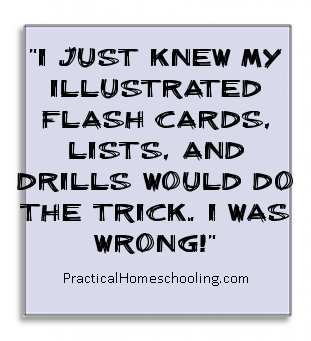Like all new homeschoolers, I was determined to teach well. Pick the
right resources and voilá—instant learning!
 I just knew my illustrated flash cards, lists, and drills on states
and capitals would do the trick. I was wrong. Instead, my daughter
Mary memorized all the states and capitals in an intense game of “Beat
the Clock” my husband cooked up on the spot while sitting with our
kids in a local fast-food joint.
I just knew my illustrated flash cards, lists, and drills on states
and capitals would do the trick. I was wrong. Instead, my daughter
Mary memorized all the states and capitals in an intense game of “Beat
the Clock” my husband cooked up on the spot while sitting with our
kids in a local fast-food joint.
To be honest, I felt miffed. And baffled. That’s when I realized that
effective learning often happens in unexpected ways.
Through the years I discovered that curricula can’t teach
everything—supplying our children with free time was also crucial. I
remember the unscheduled afternoons when Eric, Christian, Lisa, and
Mary built “Archville” in the basement. The restaurant, library,
grocery store, gas station, homes, and church—all built from
refrigerator boxes—taught valuable lessons. “We learned how to run a
town,” Lisa explained recently. “We learned to problem-solve in a
structured environment, to make laws and obey them, and to use money.”
Those real-life experiences came in handy as our children transitioned
into the working world, helping Michael and me in our first business.
We taught them to answer the phone professionally. We explained why it
was important to place the stamps neatly on packages mailed to
customers. We offered them a choice of accepting pay “by the hour” or
“by the piece” for their work. They learned what it means to operate a
home business without ever studying a book or taking a test on the
subject.
Learning also happened naturally as our children enjoyed plenty of
chances to read. Every week since Eric was a toddler, we checked out a
few carefully-chosen children’s books and magazines from the library.
They were placed on a low 2' x 3' table in the living room. No
pressure to read them. No question-and-answer sessions to follow. “I
believe that if we set out a buffet of opportunities,” our friend
Kerry suggested, “our children will respond.” He was right. Looking
back, I think my children may have learned more from that book table
than any curricula we used.
We also offered time to explore the natural world. Christian and Lisa
once decided to write and illustrate a book about The Tiny Secrets of
Our Backyard. Years later, they studied high-school biology using a
thick, detailed textbook. I’m sure they memorized more facts this way,
but now I doubt that they remember many of them. Instead, they still
recall the earlier wonder of discovery they felt while sketching
flowers, studying insects in the bug trap, and identifying a
mysterious leaf.
With our youngest child, Mary, having recently graduated and our
formal homeschooling finished after 20 years, I’m questioning whether
our children absorbed everything they needed to know. I think so. It
seems to me they’ve learned to “desire knowledge, to be inquisitive,
to want more,” as my friend Pat once wrote. She believed that “if we
help children master this process, we can say we’ve done our job, and
our kids will be lifelong learners.”
Michael and I enjoy glimpses of this process sometimes, as my husband
noted last week when all four grown children met him at Taco Bell.
Michael soaked in the conversations that wandered from diamond mining
in Siberia to fossilized dinosaur eggs. Our young adults are thinking.
They’re growing intellectually, relationally, and spiritually. This
helps me to remember that formal schooling lasts only a few years, but
learning continues. . . and often in surprising yet wonderful ways.